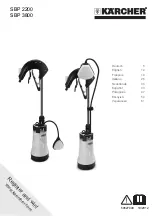
7
7.2 Unpacking and cleanup
Inspect contents of shipping container for shipping
damage. Report any damage to your distributor.
Remove all contents from carton, and compare to
the contents list in this manual. Report any part
shortages to your distributor.
Do not discard carton or packing material until
machine is assembled and working properly.
Exposed metal areas may have a rust protectant
applied. Remove this with a soft rag and solvent
such as kerosene. (Do not use gasoline, paint
thinner, acetone, etc., as these will damage
painted surfaces.)
Contents of shipping container
1
Box and Pan Brake
2
Support legs with screws
1
Instructions and Parts Manual (not shown)
1
Warranty Card (not shown)
8mm hex key required for assembly.
7.3
Assembly
8mm hex key required for assembly.
Numbers in parentheses refer to items in Figure 1.
1. Remove any straps securing the machine, and
raise into position using properly rated lifting
equipment. The floor must be stable and level.
Continue to stabilize the
machine while installing the support legs.
2. Attach the two support legs (11) with two
screws each.
3. Secure machine to floor using lag screws or
similar system. See diagram, Figure 2.
8.0
Operation
Numbers in parentheses refer to items in Figure 1.
8.1
Adjusting setback
The bending leaf blade (7) must be adjusted for
proper clearance, or “setback” (A, Figure 3) based
on material thickness (B, Figure 3). Generally,
setback for material within four gauges of capacity
should be twice the thickness of material. For
lighter gauges, use 1-1/2 times the material
thickness. Consult a machinery handbook for bend
allowances.
Figure 3
1. Loosen setback locking screws (5).
2. Rotate setback knobs (6) in equal amounts
(clockwise decreases distance).
Note: When increasing distance (counter-
clockwise), you may have to pull back slightly
on the bending leaf to take up any backlash.
3. Bring the clamping leaf into position and check
the setback.
4. Repeat above steps until proper distance is
achieved. Verify that bending leaf blade (7) is
parallel to clamping fingers (2).
5. Tighten
screws
(5).
If a crown develops in the material, this can be
adjusted out by loosening or tightening the hex
nuts on the crown adjustment rod (12). Note: This
rod has been correctly set by the manufacturer and
should only be adjusted when needed.
8.2
Adjusting clamping pressure
Clamping pressure should be great enough to hold
material securely, but not so much that it becomes
difficult to clamp
Rotate clamping adjustment knobs (3) equally to
set clamping pressure.
8.3
Repeat bends
Adjust stop bolt (4) to limit swing of bending leaf.






























